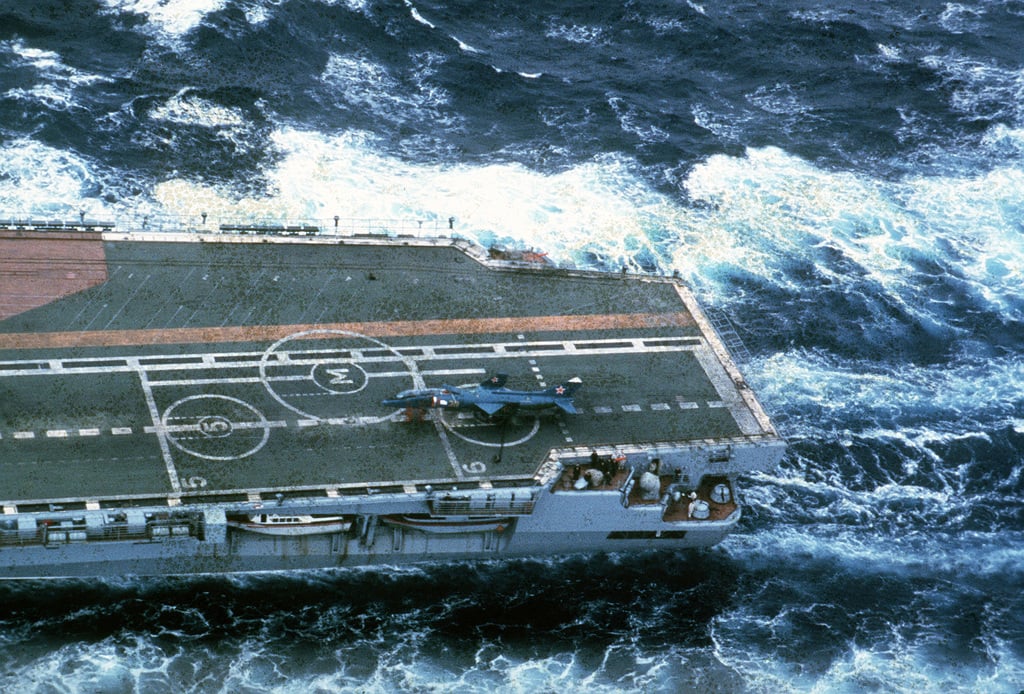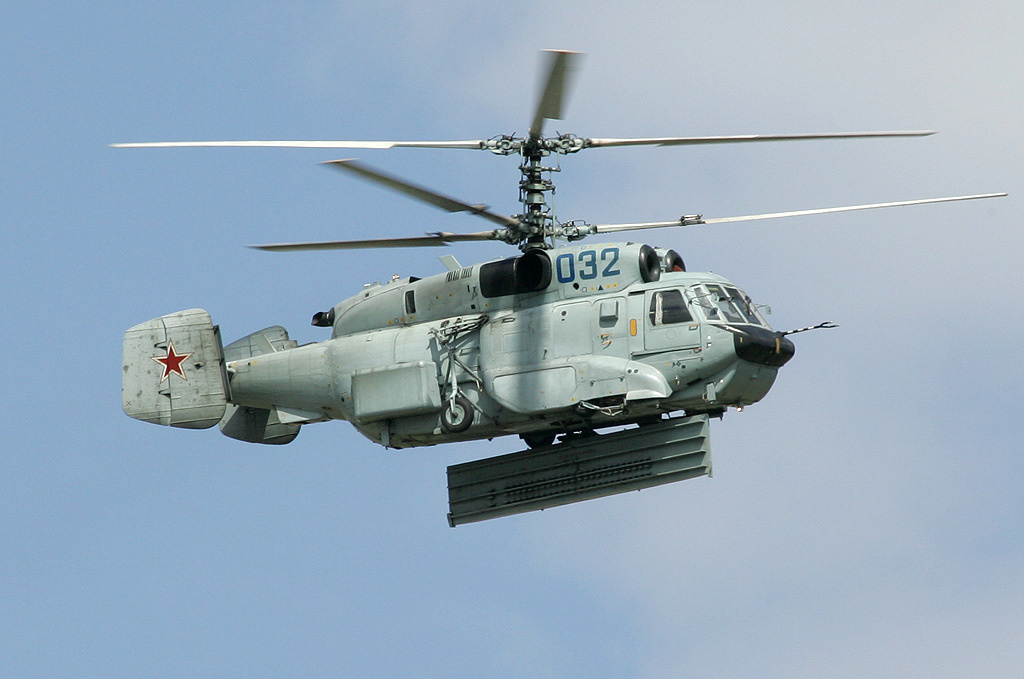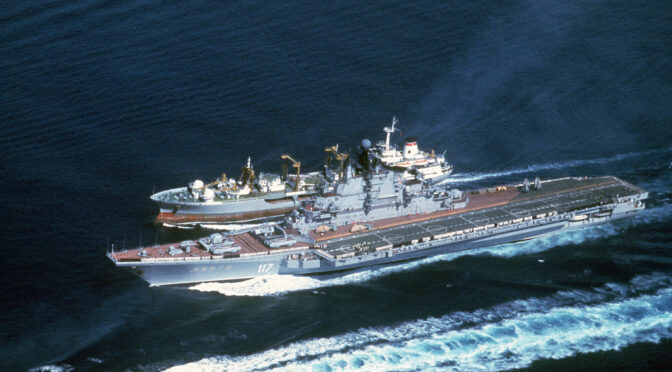The following originally appeared in the summer 1985 edition of the Naval War College Review and is republished with permission. Read it in its original form here. Read Part One here.
By Floyd D. Kennedy Jr
Impact of the Falklands/Malvinas War
The Anglo-Argentine war in the South Atlantic initiated a barrage of Soviet articles. After an initial spate of polemics on British imperialism, the naval literature assumed a much more analytic tone, and a parade of distinguished Soviet authors addressed a variety of technical and operational issues, primarily in the pages of Morskoy sbornik. Most of these articles focused on electronic warfare and air defense.
As is the case of so many important issues elaborated in the pages of Morskoy sbornik, the first major article was a tutorial. In the November 1982 issue, Rear Admiral-Engineer G. Popov discussed the role of electronic systems in the activities of naval forces, the basic principles of electronic warfare, and their importance to air defense.21 He was followed in the same issue by Rear Admiral I. Uskov, who discussed the importance of surface ships to the operational success of the British effort. Uskov’s conclusions, however, focused not on the importance of surface ships but on the necessity to provide ship formations with reliable and effective air defense:
“The Anglo- Argentine conflict showed with full clarity. . . that under modern conditions no ship is capable of effectively carrying out assigned missions without reliable air cover. The lack of aircraft carriers with long-range radar detection and control aircraft in the English formations was the reason for large losses of ships and vessels.”22
Citing “foreign specialists,” Uskov continued, “. . . low-flying anti-ship missiles may be successfully combatted if ships are armed with short-range SAM systems with minimal reaction times and automated antiaircraft gun systems.” On his own authority, he asserted that electronic warfare was extremely successful in ASMD: “In all cases when English ship captains promptly used passive jamming, the attacks of Argentine anti-ship missiles were unsuccessful, as a rule.”23
Rodionov and Novichkov reappeared as authors in the December 1982 Morskoy sbornik, where they provided a detailed, though not totally accurate, account of Argentine air attacks and British air defense dispositions during the war.24 They were joined in the January 1983 issue by Captain Second Rank Ye. Nikitin in an extensive evaluation of the electronic warfare lessons learned from the conflict. The three authors contended that because the British had no AEW organic to their naval groupings, they were forced to make exceptionally wide – and, in the case of chaff, often wasteful – use of softkill capability to combat the Argentine anti-ship missile threat. This experience pointed to specific improvements that should be made to existing systems. The two most important being the adoption of automatic systems that can rapidly switch from one form of ASMD (against radar seekers) to another (against infrared or laser seekers), and the installation of completely automated antiaircraft missiles and guns with a high rate of fire.
Rodionov et al. concluded the article with their version of the Royal Navy’s own recommendations for improving British ASMD. These recommendations were as follows:
- Equipping naval groups with AWACS [sic] aircraft
- Creating an AEW remotely piloted vehicle or tethered aerostat to perform the AWACS mission
- Improving active and passive ECM systems for countering ASMs
- Equipping carrier groups with long-range, highly maneuverable interceptors to keep the enemy at great distances from their targets (the British Sea Harrier was effective only in close-in air battles)
- Improving the ability of VTOL aircraft to intercept low-flying targets by modifying their air-intercept radars and equipping them with advanced air-to-air missiles (AAMs)
- Developing more effective long-range, surface-to-air missiles (SAMs)
- Deploying more antiaircraft gatling guns on ships
- Improving shipboard damage control capabilities.25
Inasmuch as the Soviet fleet has systems similar to those in the Royal Navy, the above recommendations could apply equally to the Soviet development efforts. Particularly appropriate was the suggestion that VTOL aircraft be armed with AAMs – Forgers with AA-8 Aphid missiles on wing hardpoints were observed for the first time on board the VTOL carrier Minsk in the Indian Ocean in December 1982.

In an article authored independently for the Soviet military newspaper Krasnaya zvezda (Red Star), Nikitin reemphasized the difficulties that confronted the British because they lacked AEW aircraft.26 The Baltic Fleet Commander in Chief Admiral I. Kapitanets echoed this theme in the February 1983 Morskoy sbornik, writing that NATO naval specialists had concluded that early warning about the air threat is basic to a successful defense against it. Using Western military surrogates Kapitanets also asserted that “‘the mission of antiaircraft and antimissile defense can be accomplished successfully only through the comprehensive employment of various means of electronic warfare and fully automated air defense, missile, and gun systems with a short ‘reaction time’ and high fire density.” He qualified this last statement with the observation that EW did not seem to deter “old” aviation tactics such as low-altitude bomb and rocket attacks.27
As if to provide historical underpinnings for Kapitanets’ assertions, Vice Admiral K. Stalbo, supposedly another ghost writer for the Soviet Navy’s commander in chief, reviewed in the same issue of Morskoy sbornik the performance of World War II fighter aviation in support of Soviet fleet operations. At one point Stalbo was critical about Soviet World War II resource allocations that could have a modern corollary,
“The air forces of the fleets did not possess special long-range fighters that to some degree would have compensated for the lack of carrier-launched fighter cover. Because of the absence of long-range fighters, the fleets were provided only with frontal aviation (tactical) fighters, and this fact greatly narrowed the opportunities for the combat employment of surface vessels.”28
He concluded that the experience of World War II correctly defined the role and place of Soviet Naval Aviation in general and by implication tactical fighter aviation within SNA, causing it to develop after the war as one of the main branches of the navy.
In a continuing equivalent of a Western “media blitz” N. Novichkovy, like his coauthor Nikitin, reiterated his Morskoy sbornik article’s main points in another publication, this time a two-part series in the February and March 1983 issues of Aviatsiya i kosmonavtika, the journal of the Soviet Air Forces. Novichkov again emphasized the British shortcoming in airborne early warning and paraphrased the prescriptions with which he, Rodionov, and Nikitin had concluded their January 1983 article. Novichkov also repeated the recommendation he and Rodionov had made in their May 1978 article for increased employment of helicopters in the ASMD role. He noted that the British had adapted some Sea King helicopters to the AEW mission, deploying them immediately after the Falklands crisis, and were discussing improvements to helicopter self-defense capabilities.29 Another naval author repeated these points in a March 1983 article in Zarubezhnoye voyennoye obozreniye (Foreign Military Review) in an apparent effort to reach a different segment of the military audience.30 The same issue carried an article on the American LAMPS helicopter system, emphasizing its ASMD role.31
In 1983, additional articles on ASMs or ASMD appeared in the April issue of Zarubezhnoye voyennoye obozreniye and the April and November issues of Morskoy sbornik. None provided additional insight into Soviet thinking on the subject, but the repetitious nature of the articles illustrated Soviet concern.32
The January 1984 Morskoy sbornik carried three articles on anti-ship missiles and fleet air defense. The first described the Israeli Gabriel air-launched ASM and noted that because the missile is compatible with the A-4 Skyhawk attack aircraft used by a number of nations, the Gabriel probably will “find wide distribution and markets.”33 Another article looked at the operational utility of employing helicopters as AEW platforms for ASMD, using the Falklands/Malvinas war as an illustration of what can happen without such a system.34

The most significant of the three January articles was the only one with a byline, that of Captain First Rank-Engineer A. Partala and Senior Lieutenant-Engineer N. Partala. Returning to the topic covered the previous January by Rodionov, Nikitin, and Novichkov, the Partalas justified this repetition by explaining that the information available to the earlier authors was often erroneous. In essence, the Partalas claimed that the South Atlantic war demonstrated that air defense weapons have very low effectiveness against ASMs, especially “with the mass missile strikes typical of modern warfare,” a situation that did not exist off the Falklands. “The possibility of providing reliable protection to combatants against strikes by a large number of missiles by the use of air defense weapons appears more and more doubtful to foreign authors in light of the Falklands experience.”
The solution to this dilemma, according to the authors, was the expanded employment of electronic warfare, because EW did not suffer from limitations such as rate of fire and missile saturation. They quoted foreign specialists as believing “that ECM capabilities can provide for the diversion of more than 80 percent of the attacking anti-ship missiles” no matter what the number. The Partalas then recommended, through their foreign surrogates,
“an acceleration in practical implementation of a number of measures that EW specialists pointed out long ago. They include in particular the equipping of ships of all types with active jamming capabilities, an improvement in means of passive jamming, increased speed of EW capabilities, and use of deck-based helicopters and aircraft equipped with radar and active and passive jamming warning gear for the protection of combatants.”35
The Partalas’ article, therefore, took issue with the earlier Rodionov et al. article that advocated a number of expensive weapon system improvements, as well as improvements in shipboard EW. The Partalas asserted that weapons may be fine for limited engagements, but only electronic warfare can be effective against massive missile attacks. The key to ASMD, according to the authors, was EW and AEW, not weaponry.
Only one more Morskoy sbornik article addressed ASMs or air defense through the middle of 1984, and it simply described Norwegian tactics for the airborne launch of the Penguin anti-ship missile.36 An article on trends in air defense in local wars in the February Voyenno-istoricheskiy zhurnal was directed to continental rather than maritime PVO. Nevertheless, some of its conclusions coincided with recommendations of naval authors for improving maritime air defense. According to the authors, the speed of warning about air attacks had acquired such importance that automation of the collection, processing, and distribution of intelligence was vital. Also, combat experience in local wars had confirmed the need for echeloned PVO in depth with antiaircraft artillery and EW for close-in and low-level defenses, surface-to-air missiles (SAMs) and artillery for medium altitudes, SAMs for high altitudes, and fighter aviation beyond and in the spaces between SAM complexes.37 This preferred configuration for land-based PVO could well provide a model for naval officers like Rodionov, Nikitin, and Novichkov who advocate long-range ship-based interceptors and improved missile and gun defenses.

Two distinct developments have influenced Soviet views on fleet air defense. The first is the steadily expanding operations of Soviet surface forces outside the air defense umbrella of land-based interceptors. The second is Western development of a qualitatively new class of weapons-small, sea-skimming cruise missiles.
The Falklands/Malvinas war demonstrated to the Soviets what could happen to their own navy if exposed to ASM attack while deployed. British deficiencies were remarkably similar to Soviet deficiencies in AEW and ASMD weaponry. But the British demonstrated an expertise in ECM that the Soviets do not have and successfully defended ships that would likely have been lost had they been Soviet. The war in the South Atlantic brought to life a threat that some Soviets had been concerned about since the late 1970s. As indicated by Soviet literature, the ASM threat received intensive high-level attention after 1982 as the primary fleet air defense problem.
Soviet authors agree unanimously on some methods of improving anti-ship missile defense, but not on others. Electronic warfare had no detractors. Automation of the collection, processing, and dissemination of information and self-defense weaponry was similarly popular. Most authors cited airborne early warning, preferably on a helicopter, as a prerequisite for any kind of ASM defense.
Disagreement appears to center on the requirement for long-range interceptors and AEW airplanes for fleet air defense. Stalbo’s allusion to an unfulfilled World War II need for long-range naval fighters as compensation for the absence of carriers in the Soviet Navy probably was a thinly veiled criticism of those who would deny the Soviet Navy modern carriers and accompanying air wings for fleet air defense. The earlier article by Tomokhovich seemed to argue that carriers were too vulnerable to provide effective bases for fleet air defense because they required enormous resources for their own self-protection. The two Partalas later implicitly supported this line of reasoning by arguing for increased ECM capabilities and against new weaponry for anti-ship missile defense. The argument over the existence of carriers in the Soviet fleet appears moot with the confirmed construction of a large-deck carrier in the Nikolayev shipyard near the Black Sea, but it may simply have shifted focus to the number of such carriers required.

V’yunenko’s 1982 article on directed energy weapons in the fleet system of ASMD is intriguing in that the concept has not been discussed elsewhere in Soviet naval literature, even in passing. The same is true of Rodionov and Novichkov’s article on airships as AEW platforms for fleet air defense. Both of these concepts are viable and may be in development. The likelihood of the latter concept reaching production probably is considerably less than the former, because several competitors to airships (AEW helicopters and AEW airplanes operating from aircraft carriers) appear more popular among the authors reviewed. Directed energy weaponry, on the other hand, has little competition in its class of destruction potential.
Judging by the literature, the 1990s’ fleet air defense system of the Soviet Navy will include a multitude of new systems: a big-deck carrier with long-range fighters and AEW airplanes embarked, AEW and ASMD helicopters dispersed throughout the surface combatant fleet, enhanced and automatic ECM, and perhaps a rudimentary directed energy ASMD system. The Soviets are very much concerned about the Western anti-ship missile threat, and if they are to continue to employ their navy as an instrument of national power, such defensive systems are an absolute necessity. Countering them is no less a requirement for Western air and naval forces.
Commander Kennedy is a professional staff member of the Center for Naval Analyses and maritime editor for National Defense. He publishes widely on US and Soviet naval and aeronautical affairs.
Notes
21. G. Popov, “The Role of Electronic Systems in the Activities of Navy Forces,” Morskoy sbornik, November 1982, pp. 75-77.
22. Ibid.
23. I. Uskov, “Lessons of the Anglo-Argentine Conflict and the Role of Surface Ships in Conflict at Sea,” Morskoy sbornik, November 1982, pp. 87-92.
24. B. Rodionov and N. Novichkov, “The Tactics of Air Operations Against Ships,” Morskoy sbornik, December 1982, pp. 80-87.
25. B. Rodionov, Ye. Nikitin, and N. Novichkov, “Electronic Warfare in the South Atlantic,” Morskoy sbornik, JJanwary 1983, pp. 77-85.
26. Ye. Nikitin, “Colonial Adventure in the South Atlantic,” Krasnaya zvezda, 14 January 1983, p. 3.
27. [. Kapitaners, “The Navy’s Role in the Anglo-Argentine Conflict,”” Morskoy sbornik, February 1983, pp. 14-20.
28. K. Statbo, ”Experience in the Use of Naval Aviation in che Great Patriotic War,” Voyennoistoricheskiy zhurnal, February 1983, pp. 25-30, trans. in JPRS 83387 (Washington: 3 May 1983).
29. N. Novichkov, “Combat Aviation in the Anglo-Argentine Conflict,” Aviatsiya i kosmonaviika, February 1983, pp. 46-47 and March 1983, trans. in JPRS 84165 (Washington: 22 August 1983), and JPRS 84063 (Washington 8 August 1983), respectively.
30. Yu. Galkin, “Air Defense of British Expeditionary Forces (During the Anglo-Argentine Conflict),” Zarubezhnoye voyennoye obozreniye, March 1983, pp. 64-67, trans. inJPRS 83591 (Washington: 2 June 1983).
31. M. Panin, “LAMPS System,” Zarbezhnoye voyennoye obozreniye, March 1983, pp. 67-72, trans. In JPRS 83591 (Washingcon: 2June 1983).
32. B. Semenov, “Anti-Ship Missiles,” Zarubezhnoye voyennoye obozreniye, April 1983, pp. 64-69, trans. In JPRS 83735 (Washington: 22June 1983), A. Partala and N. Partala, “Electronic Warfare Capahilities of Guided Missile Patrol Boats,” Morskoy sbornik, April 1983, pp. 81-84; N. Partala, “U.K. Shipboard Missile-Attack Warning Station,” Morskoy sbornik, November 1983, pp. 75-76; N. Kabalin, “Using the Land-Based Tomahawk Against Ships,” Morskoy sbornik, November 1983, pp. 81-83.
33. “Gabriel Antiship Missiles (Naval Officer Reference Data),”‘ Morskoy sbornik, January 1984, pp. 29-31.
34. “Long-Range Radar Detection Helicopters in the Ship Antiinissile Defense System,” Morskoy sbornik, January 1984, pp. 86-87,
35. A. Partala and N. Partala, “Electronic Warfare Against Antiship Missiles,” Morskoy sbornik, ]January 1984, pp. 82-85.
36. “The Tactics of Aerial Use of Penguin Antiship Missiles,” Morskoy sbornik, March 1984, pp. 87-91.
37. A. Kozhevnikov and T. Mikicenko, “On Certain Trends in the Development ofAir Defense in Local Wars,” Voyenno-istoricheskiy zhurnal, February 1984, pp. 59-64, trans. in JPRS-UMA-84-036 (Washington: 7 May 1984).
Featured Image: 1986 – An aerial port bow view of the Soviet aircraft carrier MINSK (CVHG), center, and a Boris Chilikin class oiler during an underway replenishment. (Photo via U.S. National Archives)

